Dove vs Pigeon: What’s the Difference?
Can you tell the difference between a dove and a pigeon?
The typical image of a dove is that of a white adorable bird with an olive branch in its mouth, a symbol of world peace. But what if I told you that doves can also refer to those ubiquitious rock pigeons that are found throughout Singapore?
Pigeons and doves belong to the same family of birds (Columbidae), which consists of more than 300 species of birds. They share similar features like thick and round bodies, short necks and thin peaks, but doves are generally of a smaller stature while pigeons are often larger and stubbier.
Here are some species of doves and pigeons you can find in Singapore:
Spotted Dove
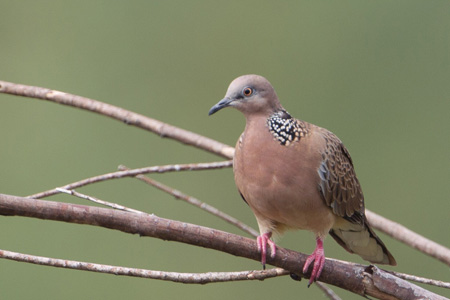
The Spotted Dove (Streptopelia chinensis) is a medium sized bird, measuring about 30 cm. Overall, it has a light brown plumage with a pinkish hue. It has darker upper parts and as its name suggests, a neck patch spotted with white. Another distinctive characteristic is its red feet.
This bird inhabits open country, scrub, plantations, gardens and urban areas. It is usually observed alone or in pairs feeding on the ground. It is a shy creature that readily takes off when disturbed.
Zebra Dove
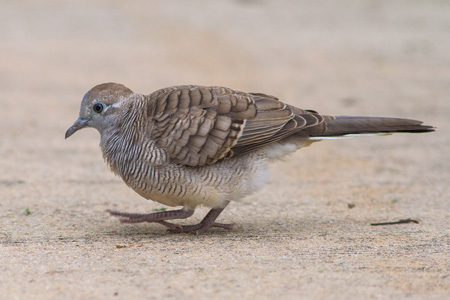
Though it has a brown plumage like the Spotted Dove, the Zebra Dove (Geopelia striata) is smaller and has a distinctive appearance. Key features include bluish facial skin and extensive barring, not spots, on its neck and breast.
The Zebra Dove is commonly seen across Singapore in various habitats. It often forages on the ground in small flocks and has a distinctive, soothing call.
Pink-necked Green Pigeon
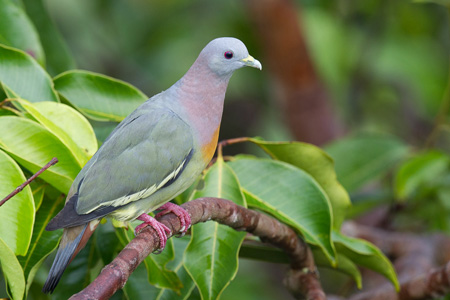
One of Singapore’s most abundant birds, the male Pink-necked Pigeon (Treron vernans) is best identified by its pink neck and orange breast patch. The female bird is mainly green, and both sexes have yellow wing bars, red legs, and a reddish eye ring.
These birds can be found in all habitats throughout Singapore, even along tree-lined streets in urban areas. They do not associate with people and spend most of their lives in the canopy feeding on fruits. Large flocks are often seen around fruiting trees.
Thick-billed Green Pigeon
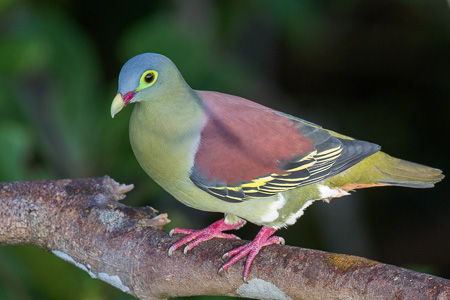
The nationally threatened Thick-billed Green Pigeon (Treron curvirostra) is largely confined to our nature reserves, where small flocks congregate around fruiting trees.
The combination of a thick greenish-yellow bill with a red base and a green eye ring is diagnostic in both sexes. The male bird has a maroon mantle, which the female lacks.
Rock Pigeon
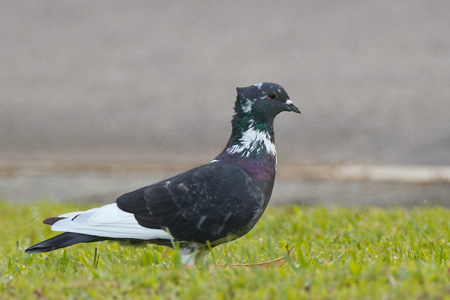
The Rock Pigeon (Columba livia) is easily identified by its greyish plumage with a darker head and neck, black wing coverts with orange irises and red legs. However, its plumage colouration is highly variable.
The Rock Pigeon can grow up to 30 cm and is an opportunistic feeder. Wild populations nest on the ledges of cliffs, which might explain why urban populations favour the ledges of buildings in urban centres. Highly adaptable, it is a ubiquitous bird that can be found throughout our mainland and offshore islands.
Want to learn more on identifying garden birds? During this stay at home period, you can do so even without leaving your house! Learn more about our common birds through our interactive e-learning module, accessible via Internet Explorer or Mozilla Firefox browser.
For more information about the flora and fauna found in Singapore, please visit Flora and Fauna Web.
If you like what you read, follow us on Facebook, Instagram and Telegram to get the latest updates.
Text by Jade Er
Photos by Francis Yap
About the writer
Jade Er is a Third Year Mass Communications student from the School of Republic Polytechnic. As part of her school’s Industry Immersion Programme (Internship), she was attached to the NParks’ Communications and Community Engagement department for five months. During this time, she contributed towards social media platforms and wrote articles for My Green Space.
Please email wong_yeang_cherng@nparks.gov.sg for more information on our internship programme.





Have views or comments on this article? Let us know via this form. If you would like to give us feedback on any other areas relating to our parks and gardens, please submit via https://www.nparks.gov.sg/feedback